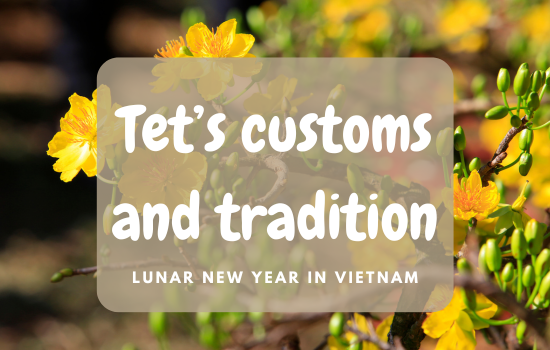


How Vietnamese people celebrate Tet - lunar new year?
In a world where holidays often blur into a homogenous mix of shopping and decorations, Vietnam's Tet holiday stands out as a vibrant tapestry of unique customs, deep-rooted traditions, and an infectious zest for life. Falling on the first day of the Lunar New Year (usually late January or early February), Tet transcends a mere calendar change. It's a spiritual reset, a family reunion, and a time to usher in good fortune with open arms.
Importance of Tet in Vietnam:
Imagine Christmas, Thanksgiving, and your birthday all rolled into one, amped up a notch with ancient rituals and a generous sprinkle of cultural magic. That's Tet for you. It's the most significant holiday in Vietnam, a time for families to reunite, ancestors to be honored, and new beginnings to be embraced. Tet washes away the old year's troubles and paints the canvas of the future with vibrant hopes and aspirations.

Pre-Tet Preparations:
Weeks before Tet, the country hums with anticipation. Homes undergo a thorough scrubbing, not just of dust and grime, but of negativity and bad luck. Every nook and cranny is cleansed, symbolizing a fresh start. Markets overflow with vibrant peach blossoms and kumquat trees, their colors and fragrance promising prosperity and happiness.
One of the most fascinating pre-Tet customs is the "Ông Công - Ông Táo" ceremony. On the 23rd day of the last lunar month, families send off the Kitchen Gods, who report their deeds to the Jade Emperor. Offerings of sticky rice cakes, candies, and paper horses await the Gods, ensuring their swift journey to heaven and a favorable report to the celestial ruler.
Tet Traditions:
The first day of Tet dawns with hushed reverence. Ancestor altars are adorned with fresh flowers and offerings, and families gather for a solemn ceremony to pay respects to their departed loved ones. Incense fills the air, carrying prayers and gratitude for blessings past.
As the day progresses, Tet explodes into a joyous celebration. Families visit relatives and neighbors, exchanging lucky money (lì xì) in red envelopes to children and the elderly.
One of the most delightful Tet traditions is the "Xông đất" - choosing the first person to enter your home on the New Year. This lucky individual, usually someone known for their good fortune and kind nature, is believed to set the tone for the family's entire year.
Tet wouldn't be complete without its culinary delights. Every family table groans with traditional delicacies like "bánh chưng" (sticky rice cakes) and "bánh tét" (cylindrical glutinous rice cakes), symbolizing yin and yang. The sweet aroma of "canh măng" (bamboo shoot soup) mingles with the savory richness of "thịt kho hột vịt" (braised pork with duck eggs), creating a sensory feast that warms the heart and belly.

Things to Avoid During Tet:
While Tet is a time for merriment, certain customs are observed to ensure a smooth and auspicious year. Avoid sweeping the floor or throwing garbage on Tet's first day, as it's believed to sweep away good luck. Lending or borrowing money is also frowned upon, as it symbolizes potential financial struggles in the coming year.
Modern Twists on Tet Traditions:
In a globalized world, even cherished traditions evolve. While the core essence of Tet remains unchanged, modern touches add a fresh vibrancy to the celebrations. Online platforms facilitate virtual reunions for families scattered across the globe, and eco-friendly alternatives are adopted to minimize the environmental impact of Tet festivities.
Copyright © 2024.Company name All rights reserved.